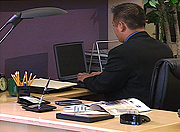
THURSDAY, April 1 (HealthDay News) — For decades, the office has been seen as the sedentary, do-nothing enemy of fitness — a place to sit eight hours a day and slowly pile on weight.
But what if it were a big part of the solution?
One expert believes it can be. In fact, in just six months, the Mayo Clinic’s Dr. James A. Levine and colleagues helped 18 Minneapolis office workers lose a total of 156 pounds, just by redesigning the office and the office workday.
“By harnessing a little creativity, one can infuse the workday with movement. And in so doing — while adjusting the way we think about food — the pounds will simply start melting off,” said Levine, who is a professor of medicine in Mayo’s department of endocrinology in Rochester, Minn.
“Patients have tried everything to lose weight and get healthy, and nothing works,” Levine said. “Many have become despondent and feel it’s hopeless. But it’s not a hopeless situation at all.”
Levine’s “healthy office” approach is rooted in what experts call “non-exercise activity thermogenesis” (NEAT).
NEAT happens naturally, as humans burn off energy with everyday movements such as standing up, fidgeting, turning, bending and walking.
According to Levine, NEAT is distinct from the other primary forms of energy-expending processes, including active exercise, at-rest metabolism, or digestion.
For most sedentary Americans, the amount of energy burnt off by active exercise is actually “negligible” compared to what’s lost via NEAT, Levine said. In fact, NEAT accounts for between 15 percent (for very sedentary people) to about 50 percent (among the very active) of daily energy expenditure. And even minor lifestyle changes can boost one’s daily NEAT by about 20 percent, he said.
So that was the kernel of Levine’s idea: Make the office a more NEAT-inducing place.
To try it out, in 2007 he and his colleagues launched a six-month experiment targeting 18 office employees at a small financial staffing business in Minneapolis.
First, the research team “re-engineered” the firm’s offices. Chairs and traditional desk-seating were replaced with desks that came pre-attached to treadmills, and walking tracks were installed around the circumference of the office to facilitate “walking meetings.”
This wasn’t exercise, Levine stressed. “You don’t run at work, you walk. And what we are trying to do in fact is to get people to walk at the office while they work at a pace of 1.1 miles an hour,” Levine said. That pace falls within the NEAT category of energy use.
Other changes subtly encouraged more movement. The office’s landline phones were replaced with mobile sets; spaces for games such as Wii and foosball were made available, and employees were also outfitted with high-tech activity monitors. Staff was also offered nutrition counseling.
The result: A half-year later the 18 study participants had lost a total of 156 pounds, of which 143 pounds were pure body fat.
On average, employees lost nearly nine pounds each, 90 percent of it in fat, and their triglyceride (blood fat) levels plunged by an average of 37 percent.
Among the nine staffers who specifically indicated a desire to lose weight when the study began, average weight loss was even higher: nearly 15-and-a-half pounds.
Weight loss did not come at the price of workplace productivity. In fact, after only three months in the reconfigured office, staffers had boosted corporate revenue by almost 10 percent. Halfway through the study, the firm registered its highest monthly gross to-date.
“This was a small study,” Levine acknowledged. “But when people who are really suffering with weight and health problems see the results it’s a very, very powerful ‘eureka moment.’ Because the trick here is that we’re not asking them to think about weight loss. We’re asking them to simply live their day in a dynamic and positive way.”
The study, which is awaiting publication, “shows that you do not have to have a gym membership to do that,” he noted. “In fact, for most people the energy burnt off at the gym is a lot lower than you might think. When you average it out over three times a week at the gym, most people are only burning off about 70 calories a day.”
“But you can achieve much more than that by infusing your day at the office with a steady level of movement without going anywhere,” Levine noted. “By taking a phone call standing up, by having a meeting walking around — slowly, a shopping pace, at maybe one mile an hour — and by taking the elevator to the third floor and walking up the other three, you will burn an extra 100 to 150 calories an hour. That’s an extra 400 to 500 calories a day. And that’s a big number.”
“If, in addition, you philosophically change the way you look at food, using food as a fuel rather than as a comfort, all of a sudden you have a weight-loss program that is available and amenable to everybody,” he added.
One expert applauded Levine’s approach, but wondered how accessible it might be for most workers.
“Yes, non-intentional exercise such as just standing instead of sitting burns more calories than if you were sitting by your computer all day. Little changes like that add up, burn calories, and make a difference,” said Lona Sandon, a registered dietician and assistant professor of clinical nutrition at the University of Texas Southwestern Medical Center in Dallas.
“But for an individual to make this kind of office place activity change they need a work environment that strongly promotes the habit,” she added. “An individual employee cannot make it happen all by himself. So unless an organization decides it’s worth putting the effort towards a remodeling it’s probably not going to happen.”
But another expert said he’s experienced the benefits of the “healthy office” firsthand.
“I’ve probably employed this approach for about twenty years, myself,” said Cedric X. Bryant, chief science officer at the non-profit San Diego-based American Council on Exercise. “People used to think I was nuts, but I do all of my editing of books and article and manuals while exercising on a step-mill — a revolving staircase type of stair climber — that I have set up, so my material is on a reading stand while I move at a very low intensity.”
“I can certainly tell when I’m working on a particularly heavy project,” Bryant chuckled, “because I lose all that much more weight.”
“And it also helps me have greater focus and mental clarity,” he added, “which makes my editing process so much easier and productive. I would say that I am probably a good 30-40 percent more productive while exercising than while sitting at my desk.”
“We need to get people to not think that the only way to get fit is through a structured experience at a prescribed intensity at the gym,” Bryant said. “We need to think of an active lifestyle being throughout the entire day, and not just during workout sessions. And if you simply move more while you work you will get the benefit you want.”
More information
There’s more on NEAT at the Mayo Clinic.

